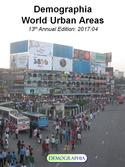In the wake of the Trumpocalypse, many in the deepest blue cores have turned on those parts of America that supported the president’s election, developing oikophobia—an irrational fear of their fellow citizens. read more »
Demographics
The Jungle
Upton Sinclair’s 1906 novel The Jungle was intended to inform the larger American public of the miserable working environment and sub survival wages of Chicago’s meat packing employees. The popular response was huge and lead to new government agencies and protections, but not the kind Sinclair had hoped for. By describing the dangerous and unhealthy conditions in slaughterhouses he meant to elicit sympathy for the workers who were denied adequate pay and were routinely maimed or killed on the job with no recourse to improved safety, medical care, or compensation. read more »
- Login to post comments
Driving Alone Hits High, Transit Hits Low in "Post-Car" City of Los Angeles
According to The New York Times, the car used to be “king” in the city (municipality) of Los Angeles. “'A Different Los Angeles', The City Moves to Alter its Sprawling Image,” was another story that seeks to portray the nation’s second largest municipality as having fundamentally changed. read more »
- Login to post comments
The Politics of Migration: From Blue to Red
Democratic “blue” state attitudes may dominate the national media, but they can’t yet tell people where to live. Despite all the hype about a massive “back to the city” movement and the supposed superiority of ultra-expensive liberal regions, people are increasingly moving to red states and regions, as well as to suburbs and exurbs. read more »
- Login to post comments
Leaving California? After slowing, the trend intensifies
Given its iconic hold on the American imagination, the idea that more Americans are leaving California than coming breaches our own sense of uniqueness and promise. Yet, even as the economy has recovered, notably in the Bay Area and in pockets along the coast, the latest U.S. Census Bureau estimates show that domestic migrants continue to leave the state more rapidly than they enter it. read more »
- Login to post comments
The 37 Megacities and Largest Cities: Demographia World Urban Areas: 2017
Many of the world’s biggest cities are getting bigger still. In 2017, the number of megacities --- urban areas with better than ten million people --- increased to 37 in 2017, as the Chennai urban area entered their ranks. Chennai becomes India’s fourth megacity, along with Delhi, Mumbai and Kolkota. These are among the major findings in the just released 13th annual edition of Demographia World Urban Areas, which provides population, land area and population density estimates for the 1,040 identified built-up urban areas (cities) in the world. read more »
- Login to post comments
Welcome to South Chicago
If you've been reading my stuff here long enough, you probably know that cringe when I hear people talk about Chicago's South Side as a monolith, as code for black and poor. The truth is, there are many facets to the South Side. It is largely black, but not exclusively so; it is less wealthy than other parts of the city and region, but with pockets of wealth also. It has its very troubled spots, but it has places of promise. read more »
- Login to post comments
The other California: A flyover state within a state
California may never secede, or divide into different states, but it has effectively split into entities that could not be more different. On one side is the much-celebrated, post-industrial, coastal California, beneficiary of both the Tech Boom 2.0 and a relentlessly inflating property market. The other California, located in the state’s interior, is still tied to basic industries like homebuilding, manufacturing, energy and agriculture. It is populated largely by working- and middle-class people who, overall, earn roughly half that of those on the coast. read more »
- Login to post comments
The End of the Asian Era
For the past 40 years, the Pacific Rim has been, if you will, California’s trump card. But now, in the age of President Donald Trump and decelerating globalization, the Asian ascendency may be changing in ways that could be beneficial to our state. read more »
- Login to post comments
What Do We Do With Shrinking Cities?
Shrinking Cities: Understanding Urban Decline in the United States
By Russell Weaver, Sharmistha Bagchi-Sen, Jason Knight, and Amy E. Frazier
Routledge (2017)
Cities like Detroit, St. Louis, and Cleveland have lost stunning percentages of their peak population since 1950. Yet these are all in metro areas whose regional populations are much higher than in 1950, even if not at their all time peak high in all of them. read more »
- Login to post comments





















